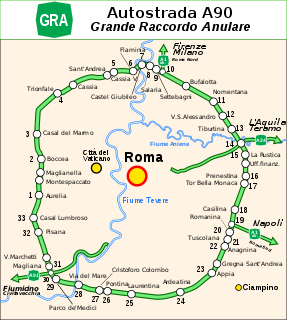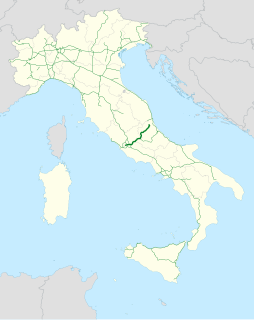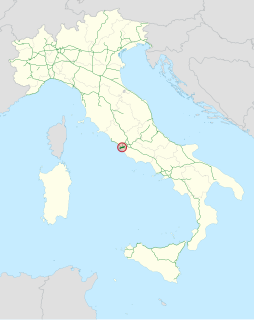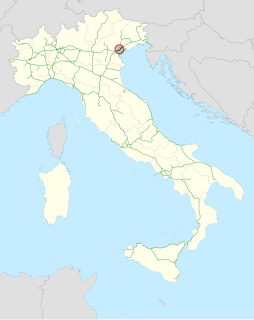
The Apennines or Apennine Mountains are a mountain range consisting of parallel smaller chains extending c. 1,200 km (750 mi) along the length of peninsular Italy. In the northwest they join with the Ligurian Alps at Altare. In the southwest they end at Reggio di Calabria, the coastal city at the tip of the peninsula. Since 2000 the Environment Ministry of Italy, following the recommendations of the Apennines Park of Europe Project, has been defining the Apennines System to include the mountains of north Sicily, for a total distance of 1,500 kilometres (930 mi). The system forms an arc enclosing the east side of the Ligurian and Tyrrhenian Seas.

Marche or The Marches is one of the twenty regions of Italy. The name of the region derives from the plural name of marca, originally referring to the medieval March of Ancona and nearby marches of Camerino and Fermo.

Ascoli PicenoItalian: [ˈaskoli piˈtʃɛːno](listen); Latin: Asculum) is a town and comune in the Marche region of Italy, capital of the province of the same name. Its population is around 46,846 but the urban area of the city has more than 93,000.

A dual carriageway or divided highway is a class of highway with carriageways for traffic travelling in opposite directions separated by a central reservation. Roads with two or more carriageways which are designed to higher standards with controlled access are generally classed as motorways, freeways, etc., rather than dual carriageways.

The Via Salaria was an ancient Roman road in Italy.

Rieti is an ancient town and comune in Lazio, central Italy, with a population of 47,700. It is the administrative seat of the province of Rieti and see of the diocese of Rieti, as well as the modern capital of the Sabina region.

San Benedetto del Tronto is a city and comune in Marche, Italy. Part of an urban area with 100,000 inhabitants, it is one of the most densely populated areas along the Adriatic Sea coast.It is the most populated city in Province of Ascoli Piceno, with 47,560. Its port is one of the biggest on the Adriatic; it is the most important centre of Riviera of the Palms, with over 8,000 Phoenix canariensis, Washingtonia and P. sylvestris plants.

Antrodoco is a town and comune in the province of Rieti, in the Lazio region of central Italy. The name derives from the Latin Interocrea.

Monti della Laga is a mountain range in the central Apennines of Italy. Their ruggedness and inaccessibility makes them one of the lesser known areas of the Italian peninsula.

The GRA or Grande Raccordo Anulare is a toll-free, ring-shaped 68.2 kilometres (42.4 mi) long orbital motorway that encircles Rome. GRA is one of the most important roads in Rome, and traffic reaches 160,000 vehicles per day as of 2011.

The Autostrada A24 or “Parks Motorway”, is a highway connecting Rome to the Adriatic Sea. Starting from GRA and ending to Teramo, the A24 create a new historical linkage between Rome and the insidious apennine mountains, alongside long-time roads Salaria, Flaminia and Tiburtina Valeria.

The Autostrada A91, also called Autostrada Roma-Fiumicino, is an Italian motorway which connects Rome to the Fiumicino Airport.
The GRAP is the orbital motorway surrounding Padua, northern Italy. It is also called Tangenziale di Padova.

The Tangenziale di Mestre, or Autostrada A57, was opened to traffic on 3 September 1972 in northern Italy.

Adriatic–Ionian motorway or the Blue Corridor, is a future motorway that will stretch along the entire eastern shore of the Adriatic and Ionian seas, spanning the western coast of the Balkan peninsula from Italy in the north through Croatia, Montenegro, Albania to Greece in the south.

The A1, also commonly Rruga e Kombit or SH10, is the longest and only toll motorway in Albania, stretching 114 kilometres (71 mi) in the counties of Lezhë and Kukës. It consists for the most part of two traffic lanes and an emergency lane in each driving direction separated by a central reservation.

Passo Corese is an Italian town and hamlet (frazione) of Fara in Sabina, a municipality in the province of Rieti, Lazio. In 2011 it had a population of 3,573.

The Highways in Albania are the central state and main transport network in Albania. The motorways and expressways are both part of the national road network. The motorways are primary roads with a speed limit of 110 kilometres per hour (68 mph). They have white on green road signs such as in Italy and other countries nearby. The expressways are the secondary roads, also dual carriageways, but without an emergency lane. They have a speed limit of 90 kilometres per hour (56 mph). They have white on blue road signs.

The Terni–Sulmona railway is a regional railway line in central Italy, managed by Rete Ferroviaria Italiana. It links three regions, Umbria, Lazio and Abruzzo, and three provincial capitals: Terni, Rieti and L'Aquila. Together with the Sulmona–Isernia railway it forms a north–south corridor through the Apennines in central Italy. Its route is the result of two unfinished railways that had to meet in Rieti: the Pescara–L'Aquila–Rome line, and the Terni–Avezzano–Roccasecca line.

The Rieti Valley or Rieti Plain is a small plain in central Italy, where lies the city of Rieti, Lazio. It is also known as Sacred Valley and Holy Valley since saint Francis of Assisi lived here for many years and erected four shrines, which have become the destination of pilgrims.
























